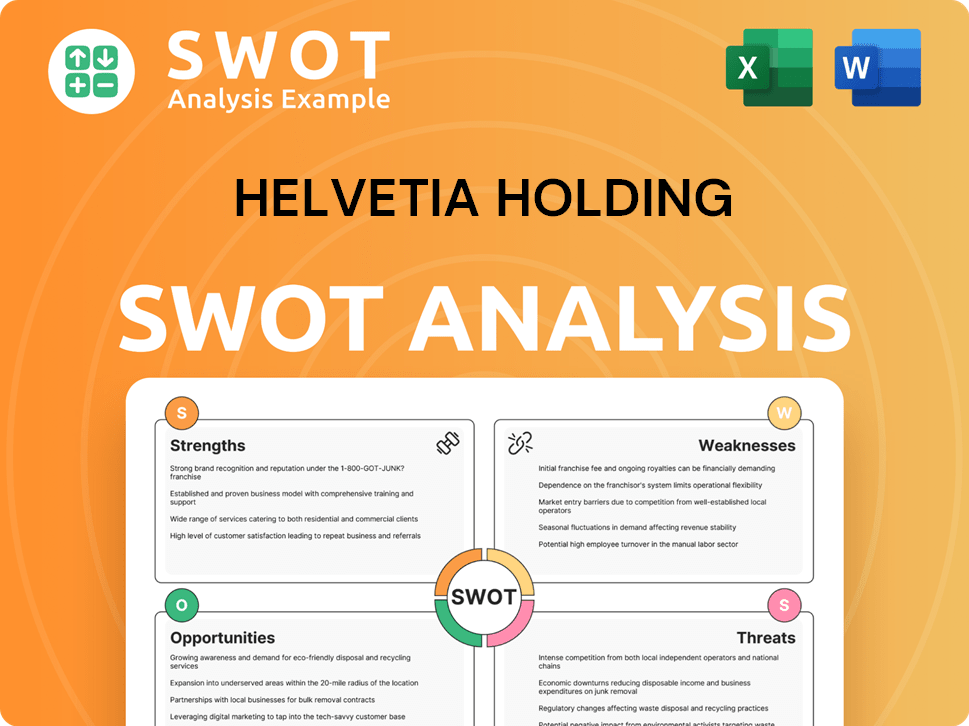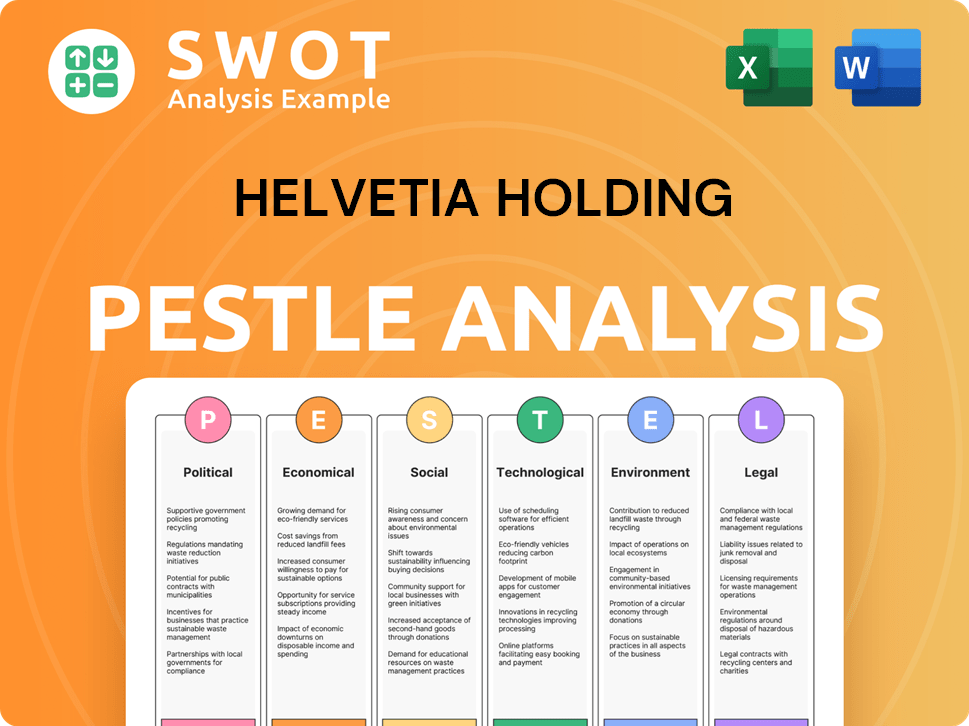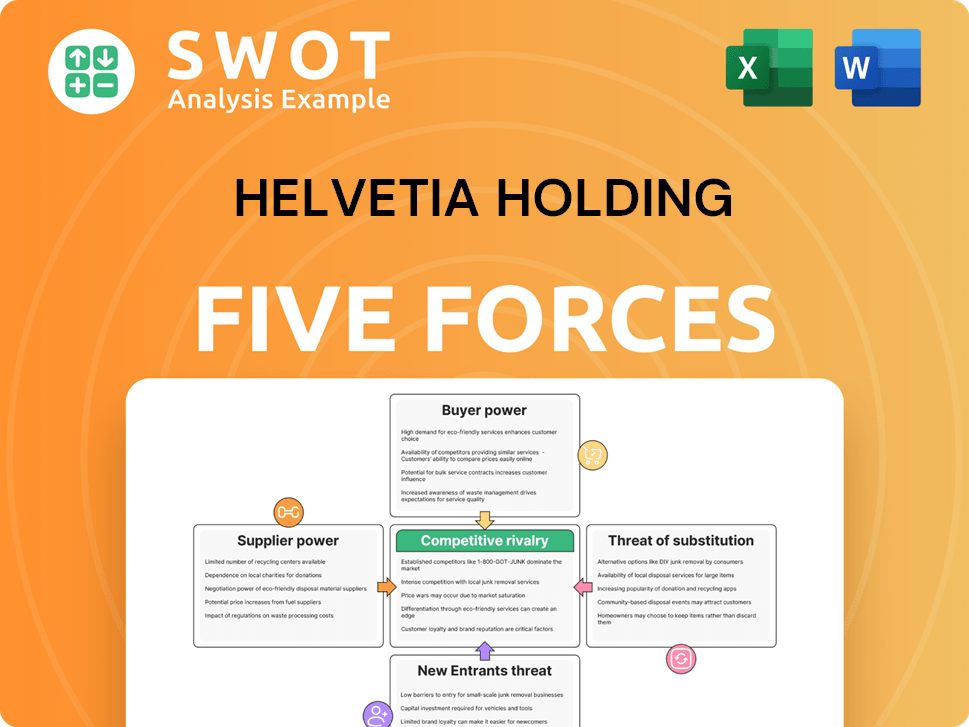Helvetia Holding Bundle
How Does Helvetia Holding Company Stack Up in Today's Insurance Arena?
The European insurance industry is undergoing a transformation, driven by technological innovation and shifting consumer demands. Helvetia Holding SWOT Analysis can provide insights into this dynamic environment. This article offers a deep dive into the competitive landscape of Helvetia Holding Company, examining its market position and strategic direction. We'll explore the company's journey, from its roots in 1858 to its current status as a leading European insurer.

Understanding the competitive landscape of Helvetia Holding Company is crucial for investors and strategists alike. This analysis will identify Helvetia Holding competitors and assess their strengths and weaknesses within the financial services sector. We'll examine Helvetia Holding Company's market share, financial performance, and business strategy to provide a comprehensive industry overview. Furthermore, it will also explore the competitive advantages of Helvetia Holding, its geographic presence, and future outlook within the insurance industry.
Where Does Helvetia Holding’ Stand in the Current Market?
Helvetia Holding AG firmly holds a significant market position within the European insurance industry. This is particularly evident in its core markets, including Switzerland, Germany, Spain, and Austria. The company's operations are centered around providing a comprehensive suite of insurance and reinsurance services, catering to both private and corporate clients. This wide range of offerings allows Helvetia to serve a diverse customer base, solidifying its presence in the financial services sector.
As of the end of 2023, Helvetia reported a business volume of CHF 11,216.7 million, highlighting its substantial scale within the insurance market. Helvetia's strategic approach involves a balanced portfolio between life and non-life insurance, coupled with investments in digital transformation. These efforts aim to improve customer experience and boost operational efficiency, which are crucial for maintaining a competitive edge in the insurance industry. To understand more about their customer base, you can read about the Target Market of Helvetia Holding.
The company's financial health is robust, demonstrated by a net profit of CHF 563.8 million in 2023. This profitability underscores Helvetia's ability to generate strong financial results compared to industry averages. Furthermore, Helvetia's solvency ratio stood at 297% as of January 1, 2024, significantly exceeding regulatory requirements. This strong capitalization provides a solid foundation for future growth and resilience in a competitive landscape.
Helvetia holds a strong position in its home market of Switzerland, where it is one of the leading insurers. The company's established presence and brand recognition contribute to its strong market share within the Swiss insurance industry. This solid base allows Helvetia to leverage its expertise and resources to compete effectively.
Helvetia's geographic presence extends across several European countries, with a focus on Switzerland, Germany, Spain, and Austria. This strategic diversification helps to mitigate risks and capitalize on growth opportunities. The company's ability to operate in multiple markets is a key aspect of its competitive strategy.
In 2023, Helvetia reported a net profit of CHF 563.8 million, showcasing its profitability. The company's strong financial performance is supported by its diverse product offerings and efficient operations. This financial strength is crucial for sustaining its market position and pursuing strategic initiatives.
Helvetia's solvency ratio was at 297% as of January 1, 2024, significantly above regulatory requirements. This high solvency ratio indicates strong capitalisation and financial stability. It provides a buffer against unforeseen risks and supports the company's ability to meet its obligations.
Helvetia continuously focuses on strengthening its market share in specific segments and regions. The company aims to achieve sustainable growth through strategic initiatives, including digital transformation and product innovation. This forward-looking approach is essential for navigating the competitive landscape and ensuring long-term success.
- Balanced portfolio of life and non-life insurance.
- Investments in digital transformation.
- Focus on customer experience and operational efficiency.
- Exploration of growth opportunities in specific segments and regions.
Helvetia Holding SWOT Analysis
- Complete SWOT Breakdown
- Fully Customizable
- Editable in Excel & Word
- Professional Formatting
- Investor-Ready Format

Who Are the Main Competitors Challenging Helvetia Holding?
The Helvetia Holding Company operates within a highly competitive insurance market, facing a diverse range of direct and indirect competitors across its various business lines and geographic regions. A thorough competitive landscape analysis is crucial for understanding its market position and strategic challenges.
The insurance industry is characterized by intense rivalry, with competitors vying for market share through various strategies, including competitive pricing, product innovation, and extensive distribution networks. The financial services sector, in which Helvetia operates, is also subject to constant change due to mergers, acquisitions, and the emergence of digital-first insurance solutions.
Understanding Helvetia Holding competitors is vital for assessing its strengths, weaknesses, opportunities, and threats, which can be further explored through a SWOT analysis. This analysis helps in formulating effective business strategies and identifying potential investment opportunities.
In Switzerland, Helvetia Holding Company competes with major players such as Zurich Insurance Group, Swiss Life, and Baloise Group. These companies offer a broad spectrum of insurance and financial services, directly challenging Helvetia's market presence.
Zurich Insurance Group presents a significant challenge due to its global reach and extensive corporate client base. As of 2024, Zurich reported a net income of $4.5 billion, showcasing its strong financial performance and competitive edge.
Swiss Life is a dominant force in the life insurance and pensions segment. In 2024, Swiss Life reported a net profit of CHF 1.1 billion, underscoring its strong position in the Swiss market.
Baloise, like Helvetia, has a strong domestic presence and competes across various insurance products. Baloise's focus on the Swiss and adjacent markets makes it a direct competitor. Baloise reported a profit of CHF 578.8 million in 2024.
In Germany, Helvetia Holding Company faces competition from major domestic insurers such as Allianz and Generali Deutschland. These companies have substantial market share and resources, making them formidable rivals.
Allianz, with its immense size and diversified offerings, presents a formidable challenge across all insurance categories. Allianz reported an operating profit of EUR 14.7 billion in 2024, highlighting its strong market position.
In Spain, competitors include Mapfre and Mutua Madrileña, both of whom have strong brand recognition and established distribution networks. These companies compete aggressively in the Spanish market.
The Austrian market sees competition from companies such as Vienna Insurance Group (VIG) and Uniqa Insurance Group. These competitors challenge Helvetia through various strategies.
These competitors challenge Helvetia Holding through competitive pricing, innovative product development, extensive distribution channels, and significant marketing expenditures. The industry also sees emerging players focusing on digital-first insurance solutions, potentially disrupting traditional models and increasing competitive pressure. Recent consolidations in the European insurance sector continually reshape the competitive dynamics, requiring Helvetia to remain agile and strategically responsive. For a deeper dive into the company's performance, you can check out this article about Helvetia Holding.
- Pricing Strategies: Competitors often use aggressive pricing to attract customers.
- Product Innovation: Developing new and customized insurance products to meet evolving customer needs.
- Distribution Channels: Utilizing diverse channels, including online platforms and partnerships.
- Digital Transformation: Embracing digital technologies to enhance customer experience and operational efficiency.
Helvetia Holding PESTLE Analysis
- Covers All 6 PESTLE Categories
- No Research Needed – Save Hours of Work
- Built by Experts, Trusted by Consultants
- Instant Download, Ready to Use
- 100% Editable, Fully Customizable

What Gives Helvetia Holding a Competitive Edge Over Its Rivals?
A thorough competitive landscape analysis of Helvetia Holding Company reveals several key advantages that set it apart in the insurance industry. These strengths are crucial for understanding its market position and potential for future growth. The company's strategic moves and operational efficiencies have significantly contributed to its success.
Helvetia's longevity and established presence in the financial services sector, particularly in Switzerland, have fostered strong customer loyalty and trust. The company's diversified business model, encompassing life, non-life, and reinsurance segments, provides a balanced revenue stream. This diversification reduces its vulnerability to fluctuations in any single market or product area, enhancing its overall financial stability.
Helvetia's commitment to digital transformation and strategic acquisitions, such as the majority stake in MoneyPark in 2021, demonstrate its proactive approach to adapting to market demands and technological advancements. These moves have expanded its service offerings and improved customer experience, positioning it well for future challenges and opportunities. Understanding these factors is essential for anyone looking into Owners & Shareholders of Helvetia Holding.
Helvetia benefits from a strong brand equity built over more than 160 years. This long-standing presence fosters trust and customer loyalty, especially in its home market. This reputation allows for easier market penetration and customer retention.
Helvetia's diversified model includes life, non-life, and reinsurance. This diversification provides a balanced revenue stream. This reduces reliance on any single segment, mitigating risks associated with market volatility.
Helvetia's robust financial health, including a 297% solvency ratio as of January 1, 2024, provides a solid foundation. This strong solvency reassures policyholders and investors. It supports underwriting capacity and financial stability.
Helvetia's localized approach in key European markets, with established distribution networks, is a competitive edge. A deep understanding of regional customer needs enhances market penetration. This strategy allows for tailored product offerings and services.
Helvetia's investment in digital transformation enhances operational efficiencies and improves customer experience. The acquisition of MoneyPark in 2021 expanded financial advisory services. This strategic move offers comprehensive solutions beyond traditional insurance.
- Enhanced operational efficiencies through digital tools.
- Improved customer experience via digital channels.
- Expansion of financial advisory services.
- Strategic acquisitions to broaden service offerings.
Helvetia Holding Business Model Canvas
- Complete 9-Block Business Model Canvas
- Effortlessly Communicate Your Business Strategy
- Investor-Ready BMC Format
- 100% Editable and Customizable
- Clear and Structured Layout

What Industry Trends Are Reshaping Helvetia Holding’s Competitive Landscape?
The Helvetia Holding Company operates within a dynamic and evolving insurance industry, where its competitive landscape is shaped by technological advancements, regulatory changes, and shifting consumer preferences. A thorough competitive landscape analysis reveals that the company faces both challenges and opportunities in maintaining and growing its market position. Understanding the industry's trends, potential risks, and future prospects is crucial for Helvetia Holding Company to make informed strategic decisions.
The financial services sector is experiencing significant transformation, driven by digital innovation and evolving customer expectations. These changes require Helvetia Holding Company to adapt its business model and strategies to remain competitive. The company's future outlook depends on its ability to navigate these complexities and capitalize on emerging opportunities.
The insurance industry is witnessing a surge in technological integration, including AI, big data, and blockchain, which are reshaping product development, risk assessment, and customer service. Regulatory changes, such as Solvency II and GDPR, add to the complexity, requiring robust compliance measures. Consumer demand for digital and personalized insurance solutions is also increasing, necessitating continuous innovation in product design and service delivery.
Intensified price competition from insurtech startups, which often have lower overheads, poses a significant challenge. The increasing frequency and severity of natural catastrophes due to climate change also impact underwriting profitability. Maintaining profitability in a competitive environment requires efficient operations and effective risk management.
Emerging markets, particularly in Central and Eastern Europe, present significant growth opportunities due to lower insurance penetration rates. Product innovations, such as parametric insurance and cyber insurance, offer avenues for expansion. Strategic partnerships with technology companies and other financial service providers can enhance Helvetia Holding Company's reach and capabilities.
To navigate these trends, Helvetia Holding Company must focus on digital transformation, sustainable growth in core markets, and strategic adaptation. Resilient strategies are crucial to counter disruptions and capitalize on new opportunities. This includes investing in technology, streamlining operations, and developing innovative products to meet evolving customer needs.
To maintain a strong market position, Helvetia Holding Company needs to focus on several key areas. These areas include digital transformation, sustainable growth in core markets, and strategic adaptation to industry shifts. These strategic adaptations will help the company navigate future disruptions and capitalize on new opportunities.
- Prioritize investments in digital technologies to enhance customer experience and operational efficiency.
- Explore strategic partnerships to expand market reach and access new capabilities.
- Develop innovative insurance products to meet evolving customer needs and preferences.
- Strengthen risk management practices to mitigate the impact of natural catastrophes and other risks.
For a deeper understanding of Helvetia Holding Company's strategic direction, consider reading about the Growth Strategy of Helvetia Holding.
Helvetia Holding Porter's Five Forces Analysis
- Covers All 5 Competitive Forces in Detail
- Structured for Consultants, Students, and Founders
- 100% Editable in Microsoft Word & Excel
- Instant Digital Download – Use Immediately
- Compatible with Mac & PC – Fully Unlocked

Related Blogs
- What are Mission Vision & Core Values of Helvetia Holding Company?
- What is Growth Strategy and Future Prospects of Helvetia Holding Company?
- How Does Helvetia Holding Company Work?
- What is Sales and Marketing Strategy of Helvetia Holding Company?
- What is Brief History of Helvetia Holding Company?
- Who Owns Helvetia Holding Company?
- What is Customer Demographics and Target Market of Helvetia Holding Company?
Disclaimer
All information, articles, and product details provided on this website are for general informational and educational purposes only. We do not claim any ownership over, nor do we intend to infringe upon, any trademarks, copyrights, logos, brand names, or other intellectual property mentioned or depicted on this site. Such intellectual property remains the property of its respective owners, and any references here are made solely for identification or informational purposes, without implying any affiliation, endorsement, or partnership.
We make no representations or warranties, express or implied, regarding the accuracy, completeness, or suitability of any content or products presented. Nothing on this website should be construed as legal, tax, investment, financial, medical, or other professional advice. In addition, no part of this site—including articles or product references—constitutes a solicitation, recommendation, endorsement, advertisement, or offer to buy or sell any securities, franchises, or other financial instruments, particularly in jurisdictions where such activity would be unlawful.
All content is of a general nature and may not address the specific circumstances of any individual or entity. It is not a substitute for professional advice or services. Any actions you take based on the information provided here are strictly at your own risk. You accept full responsibility for any decisions or outcomes arising from your use of this website and agree to release us from any liability in connection with your use of, or reliance upon, the content or products found herein.